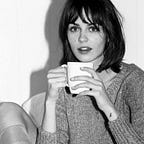what classical writers were passionate about?
When I was at the university (getting my bachelor degree in philology) and we were told some biographical information about the authors we studied I loved learning some unexpected facts from their personal lives. I was especially curious about the ways world-wide known writers liked to spend their free time. In this post I collected some bright and unusual hobbies Russian classical authors used to have. Some of them seemed very unexpected to me.
Gogol was fond of sewing, knitting and embroidery on the canvas. From the memoirs of his contemporaries we know that he could spend hours knitting woolen things, such as scarfs, yarmulkas and other trinkets [1]. With the approach of summer he began cutting up necklaces of kisaea and batiste (for himself) and fitting costumes. He was often to be seen at the table with scissors and other tailoring materials [2]. It seems that Gogol was shy of his passion, because he often tried to hide his hobby from prying eyes [1].
Turgenev was really good at hunting. He understood it well and loved it. A lot of his letters (which by the way occupy 18 out of 30 volumes of his complete works) are devoted to descriptions of his hunting successes and failures and plans to hunt with some of his friends.
Dostoevsky was a passionate gambler. He was mad about roulette. In 1862–1863 during his first trip to Europe he lost a lot and was sending letters to his acquaintances asking to borrow him money, because he didn’t have enough for the game, for a trip to another town and even for food. On his next trip to Europe he visited the casino so frequently and unsuccessfully that he had to pawn his wife’s clothes and jewelry and several times he even pawned his engagement ring [3].
Babel passionately loved horses. He was constantly looking for occasion to live near a horse farm and was thinking of writing a novel about horses. When living in Moscow he always attended races, knew the pedigree of each horse that took part in it and spent a lot of time at the stables talking to jockeys.
Ilf* was interested in photographing. Around 1930 he bought a Leica camera and began to take photos of everything he saw around. His friend and coauthor E. Petrov jokingly complained that he used to have a wonderful coauthor and some money, but then he lent his money to the coauthor and now he has neither money nor the coauthor, because Ilf is now busy taking photos, developing and printing them and again taking, developing and printing [5]. Ilf also took many photos during the journey to America in 1935–1936 and some of them appeared in «One-storied America» which was written in 1936. Ilf’s hobby affected this text in one more way: some literary techniques used in «One-storied America» suggest relationships with photography techniques.
*I. Ilf (1897–1937) — a Russian-soviet writer mostly known for the novels «The 12 Chairs» and «The Golden Calf» which were written together with E. Petrov)
Bulgakov for the whole life since his childhood participated in home performances. He wrote scripts for them and took part in the plays as an actor [7]. Theatre was not only his hobby but also a part of his job. Bulgakov wrote plays which were then staged in Moscow theatres (MKhAT studio, Vakhtangov theatre and others). He also wrote «The Theatrical Novel» in which he parodied Stanislavsky’s system and described theatrical backstage and the writing world of the USSR in 1930s.
Akhmatova enjoyed to follow fashion and wear clothes which differed her from the others and suited her. Akhmatova was a big fan of simple slouch hats (so called cloche and toque), elegant French dresses and skirts. The shawl which she would choose depending on the outfit became a part of her unique recognizable style and was always mentioned in her friends’ poems devoted to Akhmatova. A dark (not necessarily black, sometimes dark blue or deep purple) simple cut dress has also become the main symbol of Akhmatova’s style [4].
Nabokov’s most well-known hobby is collecting butterflies, but it wasn’t the only way he spent free time. He was also good at various types of sport. Being passionate about football, for many years he has been a goalkeeper in one of Russian teams in Berlin. He also boxed and it was not only a hobby but also a way of earning money: in 1920s he taught box (and tennis) to rich parents’ children. Nabokov was also good at chess and in 1932 he printed 3 chess puzzles in a French newspaper. By the way, all these types of sports are mentioned in his texts [6].
I am not really good at foreign literature and I do not know much about hobbies of the classic European, American and other authors. If you are aware of their interests, feel free to share some facts in the comments! I find it really exciting to get to know world-famous people from a new perspective and find out what they were passionate about. I think it makes famous people more relatable to us.
P.
Literature:
- Annenkov P. A. Literary memoirs. Moscow, 1989. 688 p.
- Gogol in memoirs, diaries, correspondence of contemporaries: in 3 volumes. V. 2. Moscow, 2012. 1032 p.
- Dostoevsky F. M. Complete works: in 30 volumes. Vol. 28. Letters, 1860–1868. Leningrad, 1985.
- Karateeva T. Anna Akhmatova’s clothes // Theory of fashion. Clothes. Body. Culture. 2012, №3.
- Memoirs about Ilf and Petrov. Moscow, 1963. 336 p.
- Nabokov V. V. Speak, memory. SPb, 1999. 336 p.
- Uborevich V. I. 14 letters to Elena Sergeevna Bulgakova. Moscow, 2008. 176 p.
